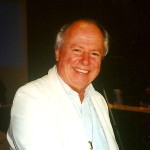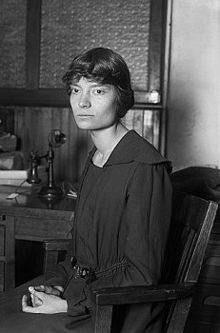Dorothy Day: Prayer and Action
BIOGRAPHIES, 28 Sep 2015
Rene Wadlow – TRANSCEND Media Service
It has probably been some time since Dorothy Day was praised in the halls of the US Congress as she was on 24 Sep 2015 by Pope Francis who said,
“In these times when social concerns are so important, I cannot fail to mention the Servant of God Dorothy Day, who founded the Catholic Worker Movement. Her social activism, her passion for justice and for the cause of the oppressed, were inspired by the Gospel, her faith, and the example of the saints.”
Dorothy Day (8 Nov 1897 – 29 Nov 1980), founder and editor of The Catholic Worker was one of the four persons that the Pope said,
“shaped fundamental values which will endure forever in the spirit of the American people. A people with this spirit can live through many crises, tensions and conflicts, while always finding the resources to move forward, and to do so with dignity. These men and women offer us a way of seeing and interpreting reality. In honoring their memory, we are inspired, even amid conflicts, and in the here and now of each day, to draw upon our deepest cultural reserves. I would like to mention four of these Americans: Abraham Lincoln, Martin Luther King, Dorothy Day and Thomas Merton.”
Since there are statue-monuments to Lincoln and Martin Luther King in Washington, it was not necessary to remind the legislators what they did. Readers of The Catholic Worker or of Thomas Merton’s autobiographic spiritual reflections written in a Trappist monastery such as Seeds of Contemplation are, no doubt, fewer on the benches of Congress. Older members may have recalled that members of the Catholic Worker movement had been among those outside Congress, the White House and the Pentagon protesting the US war in Vietnam and were then rarely called “Servants of God.”
Both Thomas Merton and Dorothy Day through their spiritual quest grew into being Catholics rather than being born into Catholic families, and the Pope in highlighting two untypical American Catholics may have wanted to stress that faith is a personal choice and not an attribute of family or ethnic status. Here I will briefly look at Dorothy Day whose page in The Catholic Worker was called “On Pilgrimage”, a reflection of her ever-moving evolution as a person.
Although Dorothy Day traveled widely “on pilgrimage” both within the USA and in Europe, she was basically tied to the lower East Side of New York City, its mixture of nationalities, of intellectuals and lower working class individuals, of social movements and Union Square demonstrations. She left home early at 18, not getting along with her newspaper reporter father, but she took with her his writing style. The father, John Day, was a reporter of sports events, primarily horse racing. There is only so much that you can say about a horse race: one horse runs faster than the others over a short distance. Thus, John Day wrote about the colorful characters that spent their time around the race track, horse owners, people who bet on horse races and who argued passionately about the qualities of the horses and how to make a “killing” by systems of betting. Dorothy Day took over the style, but rather than describing horses, she gave a human face to the poor, the unemployed, the marginalized. Her writings were not a sociological thesis on poverty in America but small portraits of the marginalized and their day-to-day efforts to survive in New York City.
Dorothy Day moved to downtown Manhattan and got a low-paying job on the Socialist daily The Call in 1917 just as the US was entering into World War I. She interviewed Leon Trotsky who was then living in exile in New York before returning to Russia and the Revolution. The Left-Socialist milieu of downtown New York was made largely of non-religious Jews who had given up arguing about the Talmud to argue about the fine points of socialist theory. As time went on the arguments became focused around Stalinists and Trotskyists − disputes which went on publicly through the 1930s until the end of World War II when the anti-Communist atmosphere made debate by Communists impossible. Dorothy Day knew many people in this Socialist milieu, in particular Mike Gold who later became the editor of the Stalinist faction’s The Daily Worker. (1)
During the mid-1920s Dorothy Day was increasingly attracted to the Catholic Church with its emphasis on prayer and the peacefulness which arose during the Mass, then said in Latin, so it was not so much the words and ideas that attracted her as being in an atmosphere which produced an inner calm during which she could establish a personal relation with God. It was only in 1932-1933 that she discovered that there was a Catholic social teaching − discovered through her meeting and collaboration with the French-born Peter Maurin who became the intellectual co-founder of the Catholic Worker movement.
Maurin was originally part of a French social-Catholic movement Le Sellon, a movement which advocated Christian democracy and which supported rural cooperatives and trade unions. Part of the Sellon ideology was a “back to nature” emphasis. Maurin left France for Canada where land was cheap. For two years, he tried to be a farmer, but he was better as a thinker than as a farmer. He then took up short-term odd jobs and traveled through Canada and the USA. He ended up in downtown New York City, always hoping to “build a new society within the shell of the old.” A mutual friend, George Shuster, editor of the Left Catholic journal Commonweal, put Maurin in contact with Dorothy Day. Maurin, ever an ideologue, saw the need for a newspaper to promote thinking about a new and just society. In France, in the 1930, the Sellon movement was largely absorbed into what was called “the personalist approach” and Maurin called himself a personalist with an emphasis on the individual person and not “the masses” − the focus of both the Communists and the Fascists at the time. (2) Maurin only wrote in prose-poem style which came to be known as “East Essays”. The reader had to make the connections among the sentences by himself as was the case for the one that was published in the first issue of The Catholic Worker.
“Christ drove the money changers
out of the Temple.
But today, nobody dares
to drive the money lenders
out of the Temple.
And nobody dares
to drive the money lenders
out of the Temple
because the money lenders
have taken a mortgage
on the Temple.
For a newspaper which was to be addressed to workers, there had to be full sentences and a structured style such as those Dorothy Day could write. Dorothy Day and Peter Maurin became co-editors of the first issue of The Catholic Worker, an eight-page paper of 2,500 copies which had cost $57, nearly all of Dorothy Day’s savings. It was printed for May 1st 1933, sold for one penny (or given away) on Union Square in New York, scene of labor and Socialist festivities.
1933 was a dark economic hole of the 1929-1939 Great Depression in the US before the New Deal reforms and the efforts of President Franklin D. Roosevelt gave some hope. There was wide agreement on the Left that both individuals and the government should take active measures to improve well-being. There could be differences of opinion on the methods but not on the aims. The themes of The Catholic Worker were those of other social-minded publications, and there was little difference of opinion among readers.
This changed radically in the summer of 1936. As Jim Forest wrote in his biography of Dorothy Day “In the summer of 1936, with the outbreak of the Spanish Civil War, Dorothy’s pacifism was tested against the reality of a war in which radicals and fascists were opposing each other, and in which the fascist side, led by Franco, presented itself as defender of the Catholic faith. Nearly every bishop and Catholic publication rallied behind Franco, considering only that he was anti-Communist and pro−Catholic. The Catholic Worker refused to support either side in the war and actively challenged Catholics in their identification with Franco”. (3)
From 1936 on The Catholic Worker has challenged Catholics and other readers to restore hope, right wrongs and promote the well-being of individuals world wide. Catholics have been divided on The Catholic Worker’s position concerning responses to the Cold War, policies toward Cuba, the wisdom or folly of “civil defense” practices in case of a Soviet atomic attack on New York in the 1950s and especially methods of opposition to the US-led war in Vietnam. The FBI files on The Catholic Worker, made available through the Freedom of Information Act showed that since 1940 it was not only Catholics who were worried about the peace building efforts of The Catholic Worker.
A good many people passed through the Catholic Worker movement, working in its houses of hospitality and farms, who then went on to play significant roles in other social movements. As Jim Forest concludes his account of Dorothy Day “she set an example which influenced many and helped bring about a reformation that reaches well beyond the Catholic Church. It is not a reformation that emphasizes abstract theological doctrine but one that centers on the presence of God, the sacredness of life, and the divinity that is hidden in the poor. It is most of all en emphasis on love. ‘Love is the measure’ she so often said ‘by which we will be judged.’
NOTES:
- For a view of the New York City Socialist-Left scene in the 1930-1940s see:Peter Drucker. Max Shachtman and His Left (Atlantic Highlands, NJ: Humanities Press, 1994).
- On the personalist movement in France see: Jean-Louis Loubet Del Bayle. Les Non-Conformists des années 30 (Paris: Seuil, 1969)
- Jim Forest. Love is the Measure: A Biography of Dorothy Day (Mahwah, NJ: Paulist Press, 1986)
__________________________________
René Wadlow, a member of the Fellowship of Reconciliation and of its Task Force on the Middle East, is president and U.N. representative (Geneva) of the Association of World Citizens and editor of Transnational Perspectives. He is a member of the TRANSCEND Network for Peace, Development and Environment.
This article originally appeared on Transcend Media Service (TMS) on 28 Sep 2015.
Anticopyright: Editorials and articles originated on TMS may be freely reprinted, disseminated, translated and used as background material, provided an acknowledgement and link to the source, TMS: Dorothy Day: Prayer and Action, is included. Thank you.
If you enjoyed this article, please donate to TMS to join the growing list of TMS Supporters.

This work is licensed under a CC BY-NC 4.0 License.

